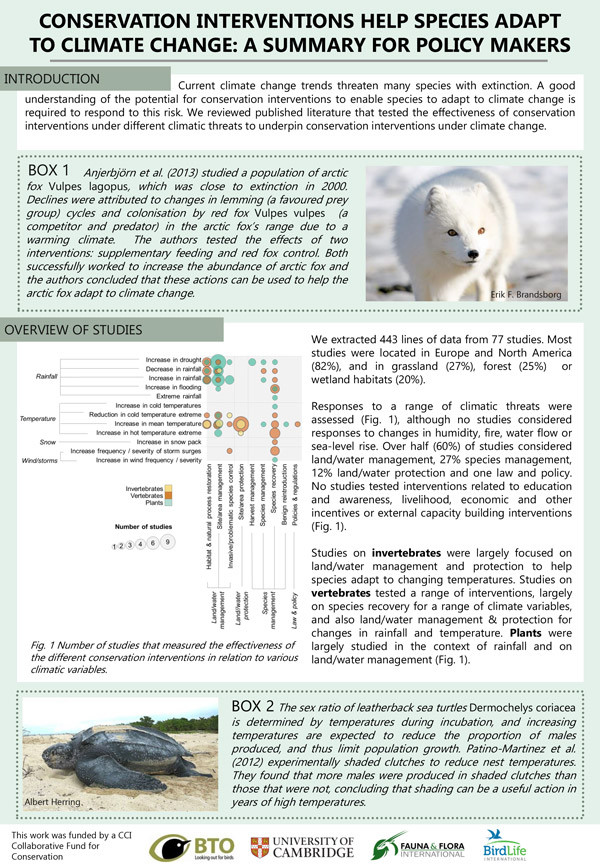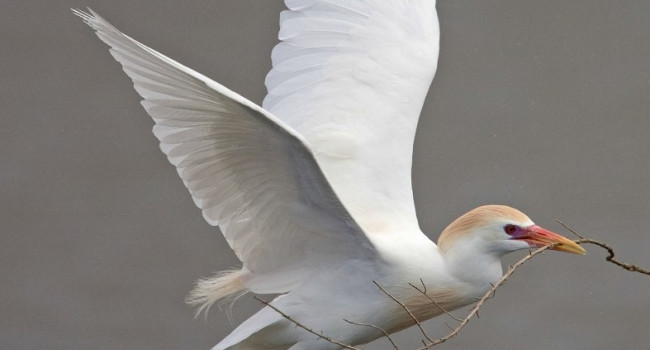Conservation interventions can benefit species impacted by climate change

Author(s): Bowgen, K.M., Kettel, E.F., Butchart, S.H.M., Carr, J.A., Foden, W.B., Magin, G., Morecroft, M.D., Smith, R.K., Stein, B.A., Sutherland, W.G., Thaxter, C.B. & Pearce-Higgins, J.W.
Published: March 2022
Journal: Biological Conservation Volume: 269
Article No.: 109524
Digital Identifier No. (DOI): 10.1016/j.biocon.2022.109524
The first quantitative global assessment of biodiversity conservation interventions for climate change adaptation has been undertaken, led by BTO researchers.
Abstract
The impacts of climate change are seen across all elements of the natural world, from the timing of biological events to species’ interactions, distributions and population sizes. Its influence is likely to increase in future, with a growing number of species at risk from climate-driven extinction. Conservation interventions can reduce these impacts by supporting climate change adaptation - interventions to reduce species’ exposure or vulnerability to climate change, or enhance the species’ capacity to adapt to climatic changes.
This study identified 77 peer-reviewed publications describing the degree of success observed for climate change adaptation interventions in terrestrial and freshwater ecosystems. Of the studies included in the research, 81% reported at least one beneficial response. Interventions with the most positive responses reported included restoration of habitat and natural processes, management of protected areas and species recovery. While the strongest evidence for positive responses was seen for birds, studies also reported positive responses for amphibians, insects and several plant groups. Overall, 30% of interventions were considered statistically significant in the benefits they conferred to species.
The most significant responses were seen for species-specific interventions; these were more likely to result in significant population-level benefits than other measures, with an estimated 73% of examples proving to be beneficial through improving productivity and survival in birds, mammals and flowering plants. This suggests that targeted conservation could reduce the climate vulnerability of particular species, through interventions like protecting species from extreme weather like flooding or heat stress through habitat management, to supplementary feeding to counter climate-driven food shortages.
While the benefit to individual species was less likely to be significant for less targeted interventions, this is probably due to a trade-off: extremely specific interventions may have a high likelihood of working on the target species, whereas broader interventions such as habitat management and site protection have the potential to benefit more species, but with a reduced likelihood of success.
The study also found equal benefit could be expected from both intentional climate change adaptation strategies and from conservation not designed specifically for climate change adaptation. For example, existing protected area networks were largely established without consideration of climate change but have been shown to play a major role in helping range-expanding species adapt to climate change. Additionally, benefits did not vary with climatic variables or habitat, but limitations in the studies available for analysis mean this is a key area for future research; more monitoring of the success of adaptation interventions, and publication of the results in the peer-reviewed literature, is required to understand potential variation more clearly.
Other urgent areas for research include more assessment of interventions in the tropics, where species exhibit different responses to climatic variability than those at higher latitudes. The effectiveness of interventions also needs to be examined in relation to socioeconomic factors such as education, conservation awareness and livelihood; these are all factors that apply to biodiversity conservation yet their impact is not well understood.
The results of this study provide hope that vulnerable species may be more receptive to interventions than previously assumed, challenging the suggestion that dwindling populations are fated for extinction and should be deprioritised so conservation resources can be used elsewhere. The authors suggest that this review is repeated in future when more data regarding conservation interventions for climate change adaptation is available for analysis. This is likely to assist decision-makers in the distribution of conservation resources and the prioritisation of conservation action in a changing climate.
Notes
Acknowledgments. We are grateful to Olly Watts for commenting on the manuscript and providing external advice through the project. This research was funded by the Cambridge Conservation Initiative, a strategic collaboration between the University of Cambridge, UK, and nine leading conservation organisations, thanks to the generosity of the Arcadia Fund.
This work was led by the British Trust for Ornithology as part of a consortium that also included BirdLife International, Fauna and Flora International and the University of Cambridge, supported by Nottingham Trent University, University of Leeds, University of Stellenbosch, Natural England and the National Wildlife Federation. It was undertaken as an activity of the IUCN Species Survival Commission’s Climate Change Specialist Group.
We thank three anonymous reviewers for helpful comments to an earlier draft of this manuscript.









Share this page